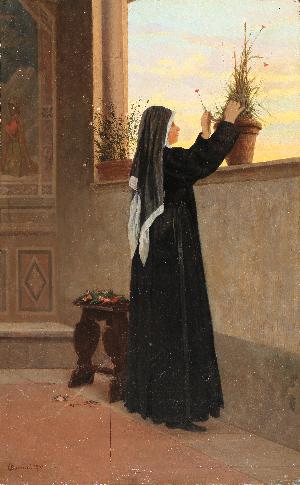BORRANI ODOARDO
PISA 1832 - FLORENCE 1905
Born in Pisa on August 16, 1832 and died in Florence on September 14, 1905. He moved to Florence in 1840, was initiated into art by his father and, later, he perfected himself first under the guidance of the painter and restorer Gaetano Bianchi, then, from 1853, by Enrico Pollastrini at the Academy of Fine Arts in Florence, practicing history painting with strong references to the fourteenth and fifteenth centuries in Florence. In the meantime, together with Telemaco Signorini and Vincenzo Cabianca, he approaches the Macchiaiolo environment gravitating around the Caffè Michelangelo and practices the first examples of life painting in the countryside around Florence (Pegentina, Pian del Mugnone). Among his first paintings, The atrium of the theater at the Pergola in the evening of a party with masks (Milan, Pontremoli collection) obtained acclaim from the Promoter of Florence and that of Genoa in 1857, while The Pazzi Conspiracy the following year was awarded with a gold medal at the Triennial Competition of the Florentine Academy. In 1859 he participated as a volunteer, together with Signorini and Martelli, in the second war of independence; the first of his three travel notebooks (formerly in the M. Galli collection in Florence) documents the patriotic momentum of these years (1858-1859). Returning from the war, in 1860 he continued his research from life in the Florentine Valdarno (Montelupo), with Banti, Cabianca, Pointeau and Signorini, and, in 1861, in the Pistoia Apennines (San Marcello Pistoiese), with Raffaello Sernesi. Here he paints, among others, those paintings that will be presented and awarded at the First National Exhibition in Florence that year: Surroundings of San Marcello, motif from life, The wheat harvest on the Apennines (Milan, Jucker collection) and Il April 26, 1859, the latter famous patriotic subject purchased by the prince of Carignano. From 1862 he began exhibiting frequently and, starting from this date, during the summer he would usually go to Castiglioncello as a guest of the critic Diego Martelli (Orto a Castiglioncello, private collection, 1862). The Stitchers of red shirts (private collection), exhibited that year in Turin together with L’ droegata, La crestaina di Firenze, La mia cucina, date back to 1863. In the meantime, together with Giuseppe Abbati, Silvestro Lega, Raffaello Sernesi and Signorini himself, he continues his research in the countryside near Piagentina, on the outskirts of Florence, the place from which their artistic association takes its name and where he will live around 1865. Here he creates some of his masterpieces: Lost Hope, sent to the Trieste Society of Fine Arts in December 1866, The First Fruits (1867), The Arno. Motivo dal vero (1868), House and marina in Castiglioncello (Montecatini, private collection), The illiterate, The call of the contingent (1869), Domestic scene in the garden (formerly the Checcucci collection, Florence), Conversation on the terrace (1872). In the summer of 1867, in Castiglioncello, he formed an artistic partnership with Giuseppe Abbati and Giovanni Fattori (Red wagon in Castiglioncello, 1867, private collection). From this period he began to paint views of the banks of the Arno and the Mugnone, including the Arno in Varlungo, purchased in 1868 by the Promoter Society of Florence. In 1870 he participated in the National Exhibition in Parma with The Call of the Contingent, in 1877 in that of Naples with Waiting for the Painter and Castiglioncello. Tuscan Maremma, and, again in 1883, to that of Rome with Curiosity, purchased by the king. In 1875 he was still with Lega to promote younger artists through his own art gallery in Palazzo Ferroni, which soon went bankrupt. Since 1879 he has been appointed Honorary Academic of Merit at the Academy of Drawing Arts in Florence. In 1880 he sent the bulletin of 9 January 1878 to Turin, inspired by the participation of Italians in the death of Vittorio Emanuele II. In 1886 he presented La maricchia, the Arno at the Casaccia and Vicolo della Scala Santa (Rome) at the first Livorno Fine Arts Exhibition and, the following year, at the National Exhibition in Venice A Christian vestal. In the following years, his participation in exhibitions became increasingly rare: in 1896-1897 he exhibited a new work, In vacation, at the Festival of Art and Flowers in Florence. In the meantime he works as a teacher in his own studio, called Piccolo Pitti, as a ceramics decorator at the Ginori factory and as an engraver and illustrator of Italian Illustration. He died in Florence on September 14, 1905.

